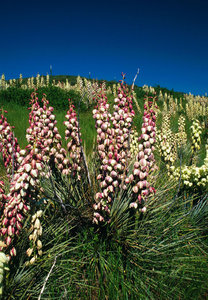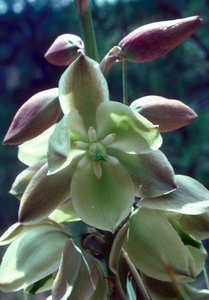

Yucca glauca. Left: Group of plants at peak of flowering, © William M. Ciesla, Forest Health Management International. Right: close-up of flowers, © Dave Powell, USDA Forest Service.
Lakota name: hupésťola, means “sharp-pointed stem” (leaves). Listen to Lakota Plant Name: hupésťola
Listen to Lakota Plant Name: hupésťola
Scientific name: Yucca glauca
Common name: soapweed
Lakota uses: Pulverized roots are mixed with tepid water, this tea was used for belly-ache. These roots were mixed with roots of uŋkcéla blaská (flat cactus) to help mothers when they cannot give birth; but they're in danger that this may make hokśiyuhapi śni pejúťa (“medicine for not give birth”). The root is also used for the making of soap; soaking the hair in a root solution is a vermin killer; it is said also to make the hair grow. Fumes from burning roots allow a horse to be caught and haltered easily.
Use by other cultures: Soap made from crushed roots is said to be a very effective treatment for dandruff and skin irritations. The roots are used for many things. They are made into a poultice and applied to inflammations, wounds, bleeding cuts, sprains, etc., but the rotten roots can also be crushed and boiled to make suds, and drinking theses suds is said to induce menopause in women, thereby making them infertile.
Secondary compounds: Soapweed roots contain a toxin that is more toxic to animals other than humans called saponin. Saponins are found in many common foods such as beans. Once you slow cook them, the saponins are destroyed.
Distribution and habitat: In South Dakota it is frequent to common on dry prairie knolls and exposed ridges, except in the NE. One of the most interesting and studied aspects concerning yuccas is the relationship between the genus Yucca and the genus Tegeticula yuccasella, also known as the Tegeticula moth, also known as the yucca moth.
Description: A 3-4 ft. wide clump of pale-green dagger-like leaves subtends (to underlie or located below) the 4 1/2 ft. flowering stalk of this yucca. The 20-30 in. long leaves are evergreen persisting for several years. Bell-shaped greenish-white pendulous flowers are followed by woody oblong cream-colored seed capsules.



 Go to quick links
Go to quick search
Go to navigation for this section of the ToL site
Go to detailed links for the ToL site
Go to quick links
Go to quick search
Go to navigation for this section of the ToL site
Go to detailed links for the ToL site